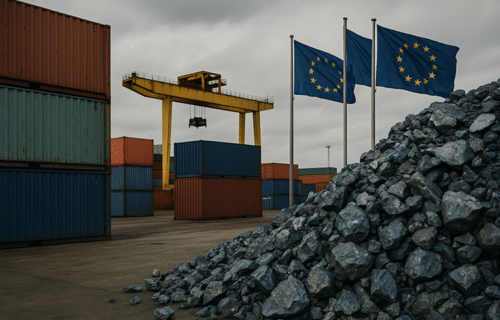Europe is confronting a growing strategic challenge as it tries to secure the raw materials that underpin its economy, defence sector, and climate goals. The European Commission plans to open a consultation before the end of the year on whether the bloc should establish strategic reserves of critical minerals. The goal is to ensure that temporary disruptions abroad no longer threaten production lines at home, particularly in industries tied to clean energy and advanced technology.
The idea reflects a shift in Brussels’ thinking. For years, policy discussions focused on boosting mining, refining, and recycling within the EU. But as geopolitical tensions have intensified, policymakers have realised that domestic production alone cannot provide full protection. Without a safety reserve to cushion sudden supply shocks, Europe’s clean-energy transition and defence manufacturing could face serious risks.
The sense of urgency is easy to understand. Europe remains deeply dependent on imports for the metals and minerals needed for batteries, wind turbines, semiconductors, and precision weapons. China continues to dominate refining of rare earths and magnet materials, Indonesia controls nickel processing, and most cobalt still comes from the Democratic Republic of Congo. When Beijing introduced new export restrictions on gallium and germanium last year, it exposed how fragile Europe’s position can be. Even as the EU promotes its internal extraction and recycling targets for 2030, the gap between ambition and real industrial capacity remains wide.
By comparison, other major economies have long prepared for such contingencies. The United States maintains a formal stockpile of critical materials managed by the Defense Logistics Agency, while Japan’s state-owned resource corporation has operated a reserve system for rare metals for decades. Both countries can draw on these stores to protect their industries in times of shortage. Europe, meanwhile, is still debating how to create a similar mechanism. Officials in Brussels are exploring how a shared reserve might be organised, how it could be financed, and which materials deserve priority treatment. Yet the discussion remains in its infancy, slowed by differences between member states and by the absence of clear budget commitments.
The consequences of delay are already visible in several industrial sectors. Europe’s wind-energy producers rely heavily on high-performance magnets made with neodymium and dysprosium, most of which are processed in China. Recycling projects are beginning to emerge in Scandinavia and Central Europe, but they remain far from meeting demand. Industry groups warn that even a brief disruption in magnet supply could stall turbine production within months, threatening the continent’s renewable-energy targets.
Battery manufacturing tells a similar story. Although new lithium and nickel mines are being planned in Portugal, Finland, and France, progress is slow due to lengthy permitting and funding constraints. Recycling offers part of the solution, with new facilities in Poland and Germany preparing to recover metals from used batteries, yet these operations are only beginning to scale. Demand for electric-vehicle components continues to grow faster than Europe’s ability to produce or recycle the necessary inputs.
Analysts say the shortfall is not simply technical but financial. The EU would need at least ten billion euros in public investment to stimulate private capital at a scale sufficient for the next decade. Brussels has identified dozens of “strategic projects” under its critical-materials policy, but most are still at an early stage of development. Without dedicated funding, the vision of a resilient European supply chain risks remaining on paper.
The debate over stockpiles is as much about design as it is about urgency. Proponents argue that reserves could serve as a vital insurance policy, giving Europe room to manoeuvre during crises. Skeptics caution that poorly planned stockpiles could distort markets or lock in inefficient spending. Many experts believe the most realistic outcome will be a selective system focused on the most essential materials—those with limited substitutes or high defence relevance—combined with continued efforts to expand domestic processing and recycling.
For now, the European Commission hopes its forthcoming consultation will produce consensus on how to balance speed, cost, and environmental responsibility. The bloc’s competitors have decades of experience managing mineral reserves; Europe has a framework but few tangible assets. Whether it can close that gap will depend on how quickly intentions are translated into warehouses filled with the minerals that keep its industries running.
As one industry observer put it, Europe’s challenge is not just to mine faster but to think further ahead. In a world where access to raw materials defines strategic power, the continent’s ability to build a credible safety buffer may well determine how secure its future truly is.
Sources: CIJ.World analysis based on public data from the European Commission, WindEurope, the International Energy Agency, Reuters, and other professional reports.
